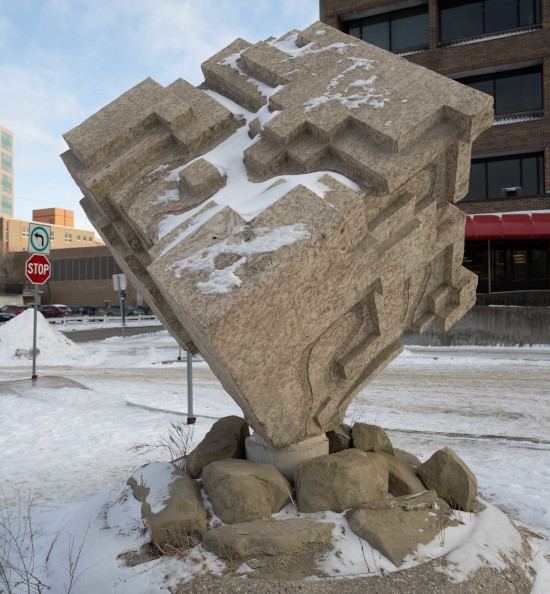Art at stake
City of Winnipeg slashes public art funding in draft budget

David Perrett’s sculpture city.block.stop, located by the Ellice Avenue bus stop at the University of Winnipeg - Photo by Keeley Braunstein-Black
In The Death and Life of Great American Cities, author and urbanist Jane Jacobs posits public art as an essential pillar of city life.
“We need art, in the arrangements of cities as in the other realms of life, to help explain life to us, to show us meanings, to illuminate the relationship between the life that each of us embodies and the life outside us,” Jacobs writes.
In Winnipeg, the future of public art – the work that visually narrates the city’s story – is at stake. The city’s 2024 draft budget lists no dedicated funding for public art.
Funding for the Public Art Program, which was established two decades ago, has declined considerably between 2019 and now. From its inception in 2004 to 2018, the city dedicated $500,000 a year to public art projects. In 2019, it was reduced to $250,000 and $125,000 in 2022.
Now, it sits at zero.
Carol Phillips, the executive director of the Winnipeg Arts Council (the body that administers the city’s Public Art Program), believes the cuts will come with drastic consequences.
“If we don’t have funding from the City of Winnipeg, we cannot convince other levels of government (to invest),” Phillips says. “If the city is not going to invest, no one else is, either.”
Kelly Campbell, a participating artist in the WITH ART/Youth WITH ART programs delivered through the Winnipeg
Arts Council’s Public Art Program, fears the adverse impact the cuts will have on community outreach.
Every year, organizations across the city apply to WITH ART to develop an art project with a local artist around themes of identity and local connections. However, without proper funding, Campbell says it’s likely the program will not exist in the coming years.
“The worst thing about it is that you can’t actually even see (the impact) until later,” Campbell says. “It’s like a generational loss.”
Across the city, public art landmarks remind residents and inform visitors of Win- nipeg’s living history. The Rooster Town Kettle, created by artists Bill Burns and Ian August, marks the site of the historic Métis road-allowance community along the present-day Southwest Transitway.
In the heart of Winnipeg’s Exchange District, Bernie Miller and Noam Gonick’s Bloody Saturday streetcar commissioned through the Public Art Program reminds passersby of the 1919 General Strike that took place on the same grounds.
The construction of Bloody Saturday was made possible by the labour of trades workers – labour Phillips argues attests to the wider economic benefit of public art.
“All of that money is only reinvested in the community,” she says. “All the money that results in public art projects goes to
that whole array of people that work together to make it happen.”
Without municipal public arts funding, it is unlikely that these visual landmarks would exist.
To dissuade the city from moving forward with the cuts, Campbell plans to speak as a delegate at the Standing Policy
Committee on Community Services meetings on March 11 and 17.
“Public art should be made by the people that live in the community, and this is like the only opportunity that people really have to do that in the city,” they say. “We don’t even know what we’re losing.”
Published in Volume 78, Number 20 of The Uniter (March 7, 2024)






